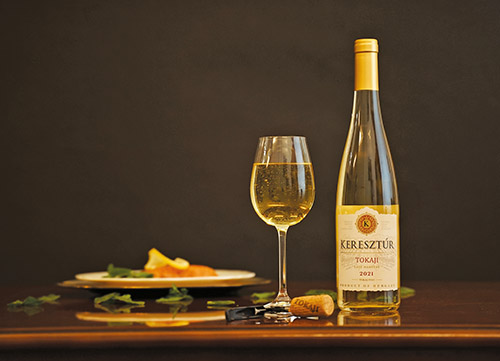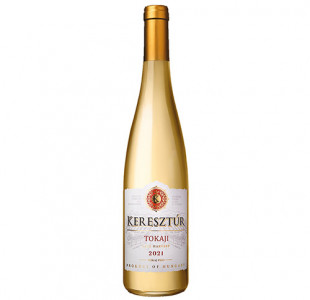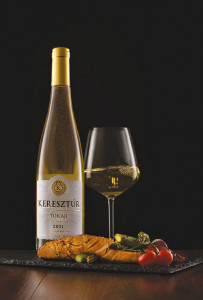
As I was preparing this article about the Tokaj (pronounced tock-eye) region’s famous wines, news broke about the unfortunate incident at the Frankfurt airport with alleged antisemitic undertones. A group of 100 or so Chasidim, on their way to the tomb of Rebbe Yeshaya (Reb Shaya’le) Steiner to mark his yahrzeit, were prevented from boarding their connecting flight to Budapest. Last week, 20,000 Jewish pilgrims journeyed with pent-up excitement to spend Gimmel Iyar at the Tziyun in Bodrogkeresztúr, both because war has precluded visits to Rebbe Nachman of Breslov’s tomb in Ukraine, and because of the end of two years of COVID-related travel restrictions.
Guides to visiting Jewish Kerestir recommend Tokaji wine tours, but warn that there are no kosher wines to taste. Their advice is out of date—there is, in fact, kosher Tokaji: Chateau Keresztúr, produced right on the outskirts of Kerestir!
Tokaji is made from a blend of the six varietals approved for use in the Tokaj appellation. However, 60% of local vineyards (9,800 acres) are planted with Furmint, a white grape native to the region. Other important grape varieties are Hárslevelű and Sárgamuskotály, also known as Muscat Canelli. All six are susceptible to botrytis, also known as “noble rot,” a fungus that grows on moist grapes, dehydrating them and concentrating their sugars, minerals and fruit acids.

The combination of the Tokaj district’s vines, climate, topography and soil composition contribute to the uniqueness of its wines. Straddling the Hungarian/Slovak border, the clay and loess soil of the Tokaj plateau sits over a lime- and iron-rich volcanic substratum that imprints the vines with their distinctive mineral profile. This 1,500 foot high tableland’s proximity to the Bodrog and Tisza Rivers and the southern edge of the Western Carpathian Mountains creates a distinctive microclimate. The weather pattern is marked by bitterly cold, windy winters; cool, dry springs; hot summers; and rainy, cold early autumns followed by long warm spells that allow for a protracted ripening.
Cultivating the drought-resistant sibling of such well-known grapes as Chardonnay, Riesling and Gamay is rewarding but sensitive work. Budding early in the spring, sudden, late frosts can kill off Furmint’s shoots. Thick-skinned Furmint berries grow in loose bunches and are versatile, traditionally used to produce sweet dessert wines. As the grapes ripen, Furmint’s skins become lighter and translucent, with sunshine increasing the sugar concentration in the berries due to water evaporation. Early autumn rains fall before the grapes are fully ripe. At this stage, some damaged grapes get infected by the botrytis cinerea fungus.
Knowing that Furmint is prone to botrytis when fall rains are followed by drier conditions, farmers intentionally let their crop over-ripen and begin their harvest late, in December. This allows the fungus to spread over the clusters, dehydrating the grapes and, as mentioned earlier, leaving behind high concentrations of fruit sugars, minerals and acid. The resultant higher acidity gives the resultant wines excellent aging potential.
Six different sweet wines are produced in Tokaj, each made by preparing the botrytised grapes and their must in a different fashion. In the past 20 years, a new, dry style has also been developed.

Today, use of the Tokaj designation is jealously guarded by the European Union, which restricts the name to wines originating in this historical locality in Hungary and Slovakia. The appellation produces roughly 2.9 million gallons of wine a year; in comparison, Israel produces approximately 7.9 million gallons of wine annually.
Recognizing the exceptional character of the wines and the distinctiveness of the physical surroundings and meteorological conditions, starting in 1730 the Austrian Empire began to define the Tokaj appellation, classifying vineyards in a three-tier system, depending on their exposure to sunlight, soil composition and propensity to develop “noble rot.” This appellation was among the first in the world, established by imperial decree in 1757 and finalized via the censuses of 1765 and 1772.
Tokaji’s exceptional flavor and complexity were appreciated outside the Empire, too. Following his failed rebellion against the Austrian crown, Francis II Rákóczi, Prince of Transylvania, gave his patron, King Louis IV of France, wine from his estate in Tokaj. The Sun King pronounced the wines “Vinum Regnum, Rex Vinorum!”—”Wine of Kings, King of Wines!” Later, Austro-Hungarian Emperor Franz Josef had a custom of sending Queen Victoria of Britain Tokaji on her birthday. Various other monarchs and rulers collected and consumed the expensive beverage and its reputation spread in poetry and literature.
According to legend, Reb Shaya’le Kerestirer spent large sums, too. But unlike the aristocrats who lavished expensive Tokaji on each other, Reb Shaya’le supported needy families across Hungary, provided hachnasat orchim for ordinary travelers and hosted his impoverished village at large melave malkas every Motzei Shabbat. Mirroring the tzadik’s humility, most of the faithful who travel to his final resting place from across the globe seeking spiritual strength and praying for divine guidance are unaware that they are in the heart of what was once royal wine country.
Chateau Keresztúr Tokaji Late Harvest 2021, Tokaj, Hungary: Golden yellow to the eye with aromas of wild flowers, nectarine, apricot and honeysuckle. Medium bodied, it has flavors of apricot, tropical fruits and hints of pear and honey. The sweetness is balanced by minerality and high acidity. Residual sugar of 12.3% conceals the 9.5% alcohol by volume. Ready to drink, the wine will continue to improve over the next few years. Pair it with sweet desserts, fruit salad or tangy blue cheese.
Shimon Oppenheim lives in Teaneck and works for Red Garden Inc., importer of Chateau Keresztúr.










